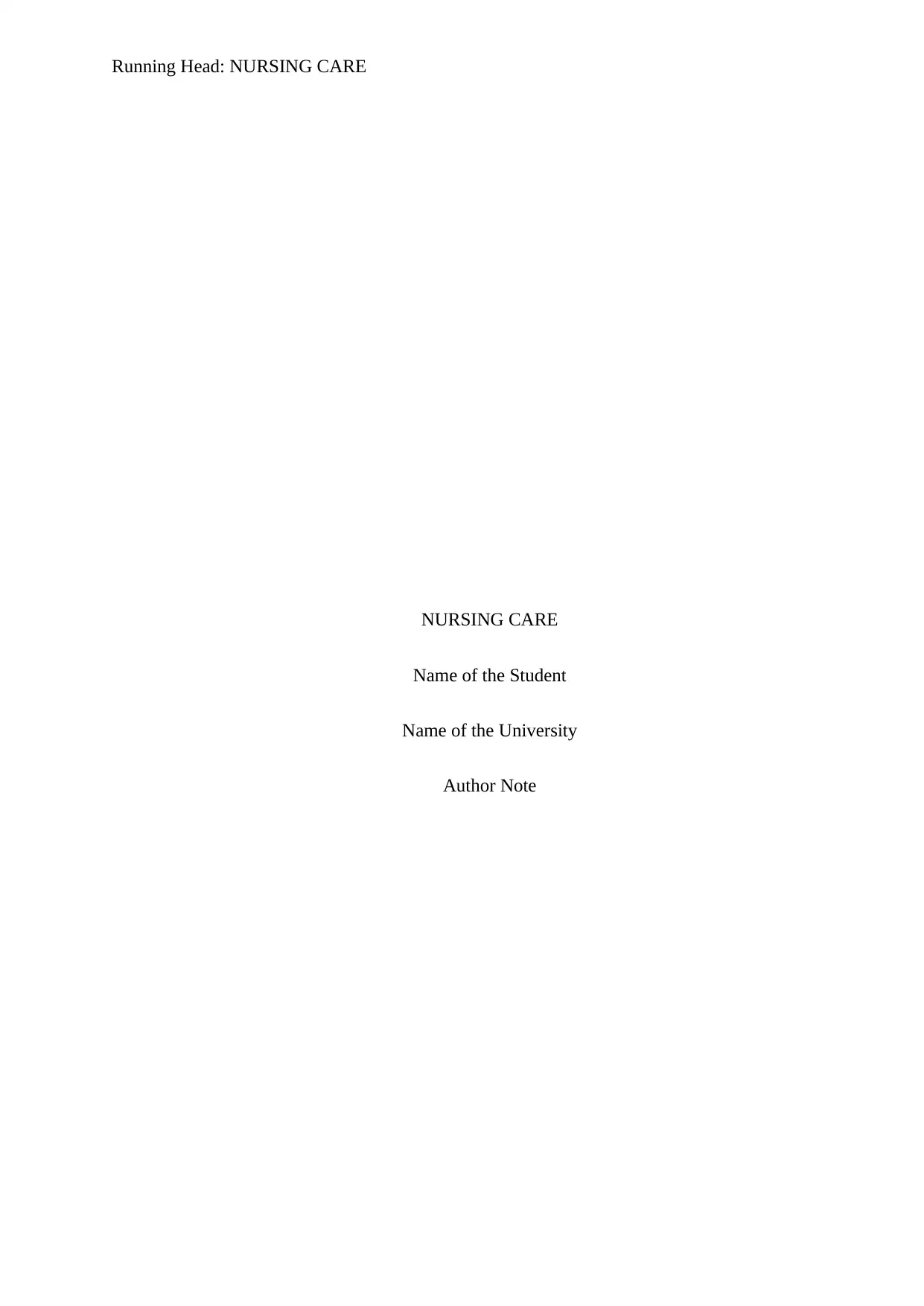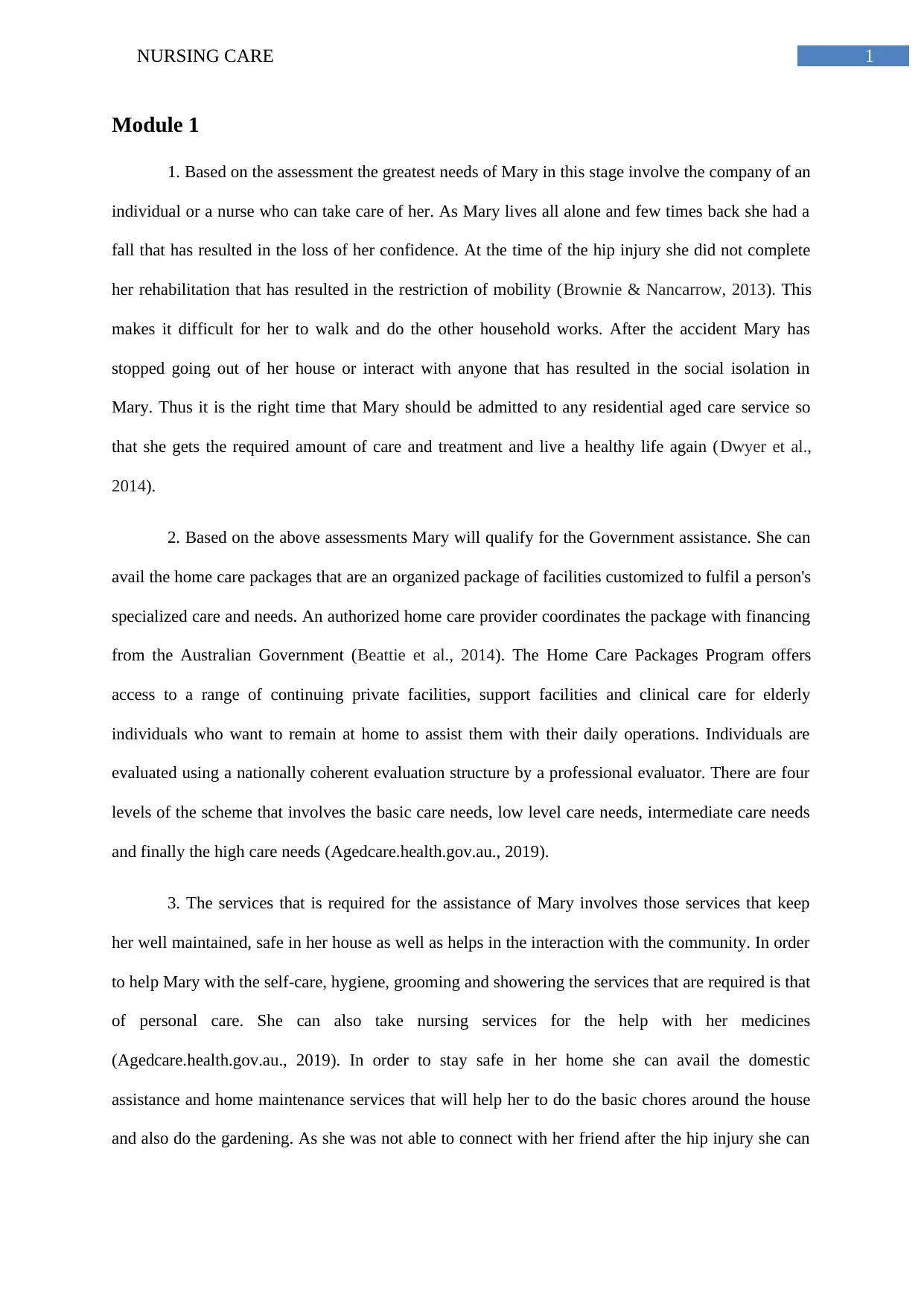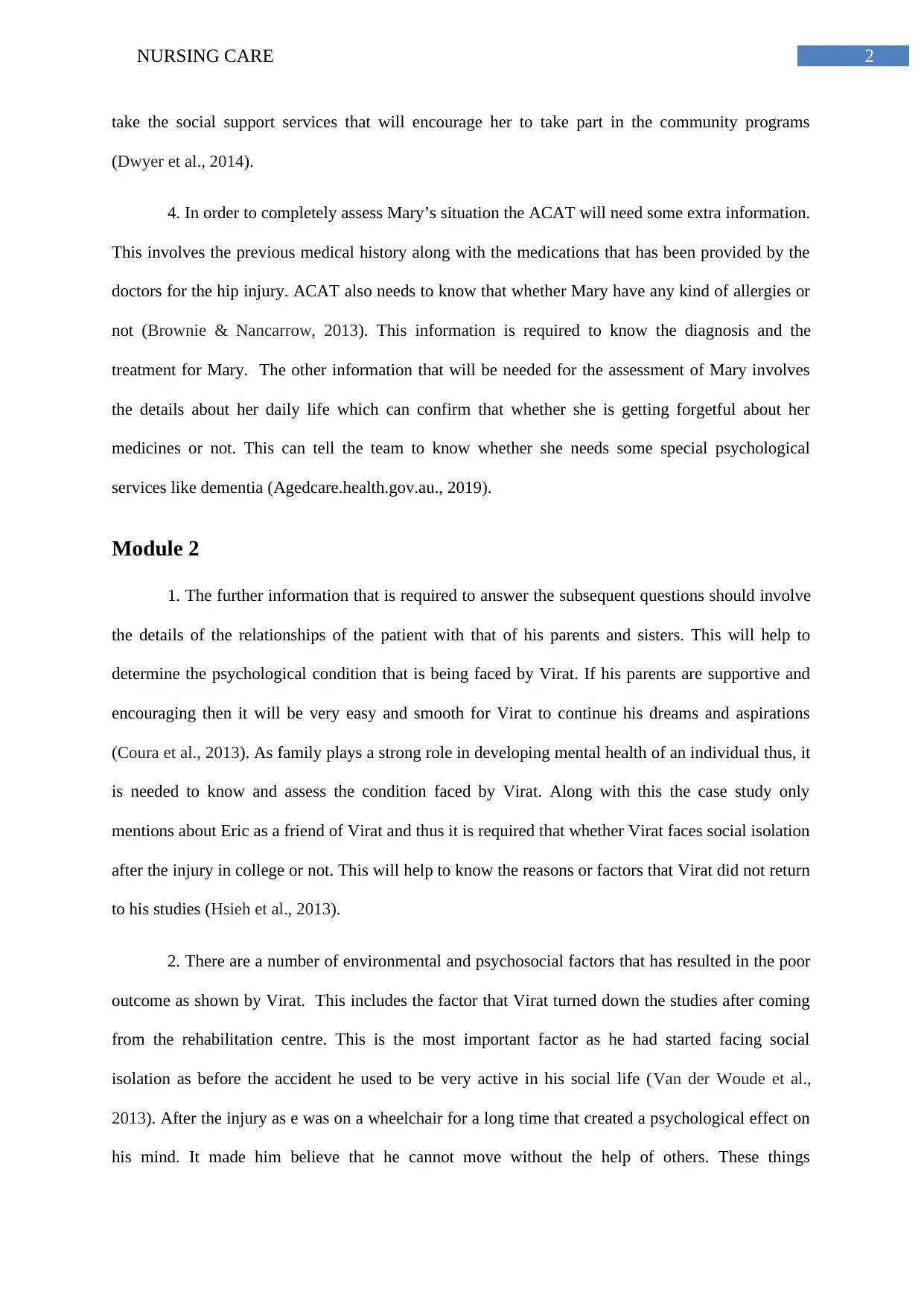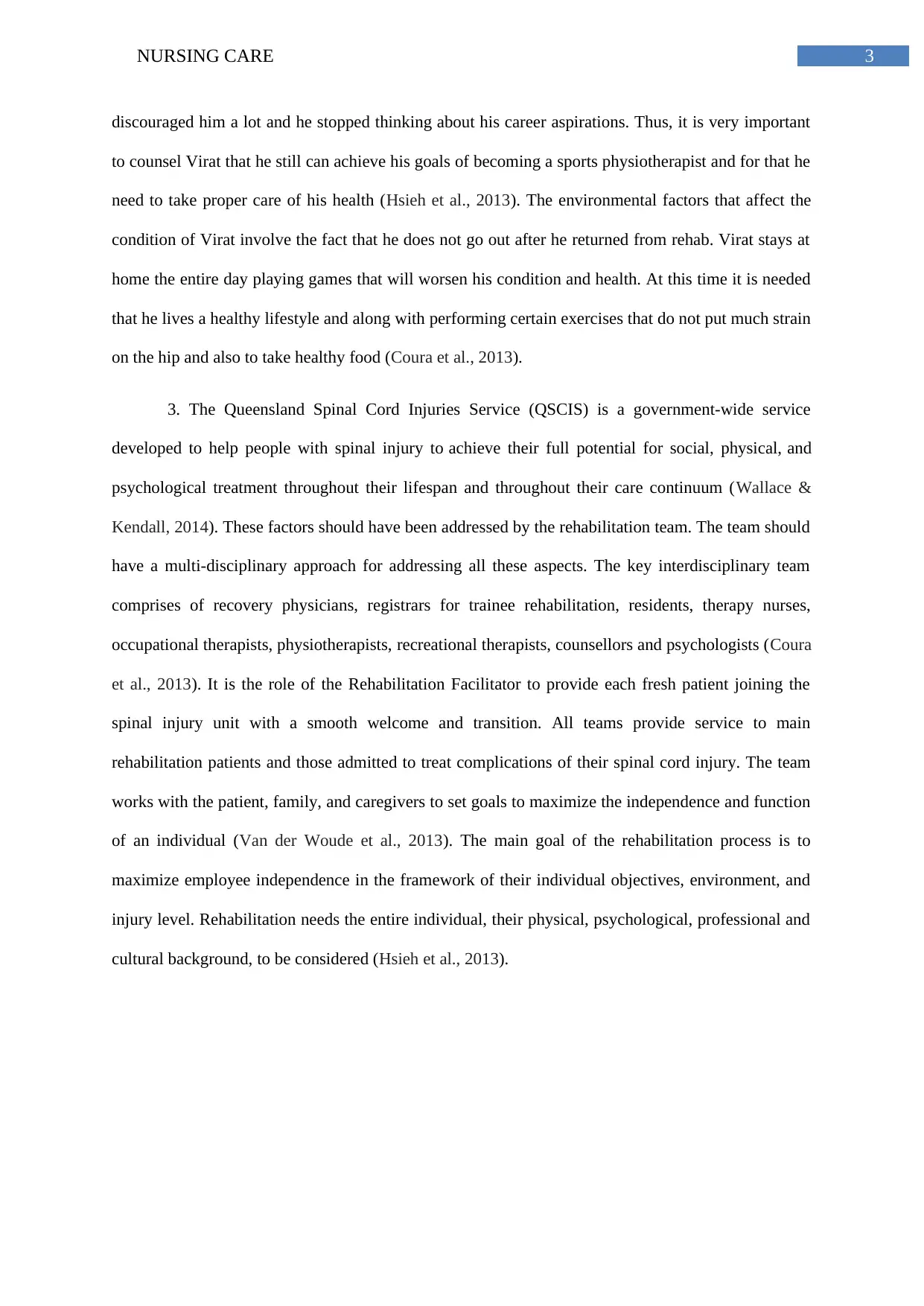Nursing Care Assignment: Analysis of Aged Care and Spinal Injuries
VerifiedAdded on 2022/11/15
|5
|1676
|417
Homework Assignment
AI Summary
This nursing care assignment solution addresses two case studies focusing on aged care and spinal injuries. Module 1 analyzes the needs of an elderly woman, Mary, assessing her need for residential care, eligibility for government assistance (Home Care Packages), and required services like personal care and social support. It also outlines the additional information needed for an ACAT assessment. Module 2 examines the case of Virat, a young man with a spinal cord injury, exploring environmental and psychosocial factors affecting his rehabilitation outcome. It discusses the role of the Queensland Spinal Cord Injuries Service (QSCIS) and the multidisciplinary rehabilitation team. The assignment highlights the importance of comprehensive care, addressing both physical and psychological needs, and emphasizes the significance of environmental and social support for patients' well-being and successful rehabilitation.

Running Head: NURSING CARE
NURSING CARE
Name of the Student
Name of the University
Author Note
NURSING CARE
Name of the Student
Name of the University
Author Note
Paraphrase This Document
Need a fresh take? Get an instant paraphrase of this document with our AI Paraphraser

1NURSING CARE
Module 1
1. Based on the assessment the greatest needs of Mary in this stage involve the company of an
individual or a nurse who can take care of her. As Mary lives all alone and few times back she had a
fall that has resulted in the loss of her confidence. At the time of the hip injury she did not complete
her rehabilitation that has resulted in the restriction of mobility (Brownie & Nancarrow, 2013). This
makes it difficult for her to walk and do the other household works. After the accident Mary has
stopped going out of her house or interact with anyone that has resulted in the social isolation in
Mary. Thus it is the right time that Mary should be admitted to any residential aged care service so
that she gets the required amount of care and treatment and live a healthy life again (Dwyer et al.,
2014).
2. Based on the above assessments Mary will qualify for the Government assistance. She can
avail the home care packages that are an organized package of facilities customized to fulfil a person's
specialized care and needs. An authorized home care provider coordinates the package with financing
from the Australian Government (Beattie et al., 2014). The Home Care Packages Program offers
access to a range of continuing private facilities, support facilities and clinical care for elderly
individuals who want to remain at home to assist them with their daily operations. Individuals are
evaluated using a nationally coherent evaluation structure by a professional evaluator. There are four
levels of the scheme that involves the basic care needs, low level care needs, intermediate care needs
and finally the high care needs (Agedcare.health.gov.au., 2019).
3. The services that is required for the assistance of Mary involves those services that keep
her well maintained, safe in her house as well as helps in the interaction with the community. In order
to help Mary with the self-care, hygiene, grooming and showering the services that are required is that
of personal care. She can also take nursing services for the help with her medicines
(Agedcare.health.gov.au., 2019). In order to stay safe in her home she can avail the domestic
assistance and home maintenance services that will help her to do the basic chores around the house
and also do the gardening. As she was not able to connect with her friend after the hip injury she can
Module 1
1. Based on the assessment the greatest needs of Mary in this stage involve the company of an
individual or a nurse who can take care of her. As Mary lives all alone and few times back she had a
fall that has resulted in the loss of her confidence. At the time of the hip injury she did not complete
her rehabilitation that has resulted in the restriction of mobility (Brownie & Nancarrow, 2013). This
makes it difficult for her to walk and do the other household works. After the accident Mary has
stopped going out of her house or interact with anyone that has resulted in the social isolation in
Mary. Thus it is the right time that Mary should be admitted to any residential aged care service so
that she gets the required amount of care and treatment and live a healthy life again (Dwyer et al.,
2014).
2. Based on the above assessments Mary will qualify for the Government assistance. She can
avail the home care packages that are an organized package of facilities customized to fulfil a person's
specialized care and needs. An authorized home care provider coordinates the package with financing
from the Australian Government (Beattie et al., 2014). The Home Care Packages Program offers
access to a range of continuing private facilities, support facilities and clinical care for elderly
individuals who want to remain at home to assist them with their daily operations. Individuals are
evaluated using a nationally coherent evaluation structure by a professional evaluator. There are four
levels of the scheme that involves the basic care needs, low level care needs, intermediate care needs
and finally the high care needs (Agedcare.health.gov.au., 2019).
3. The services that is required for the assistance of Mary involves those services that keep
her well maintained, safe in her house as well as helps in the interaction with the community. In order
to help Mary with the self-care, hygiene, grooming and showering the services that are required is that
of personal care. She can also take nursing services for the help with her medicines
(Agedcare.health.gov.au., 2019). In order to stay safe in her home she can avail the domestic
assistance and home maintenance services that will help her to do the basic chores around the house
and also do the gardening. As she was not able to connect with her friend after the hip injury she can

2NURSING CARE
take the social support services that will encourage her to take part in the community programs
(Dwyer et al., 2014).
4. In order to completely assess Mary’s situation the ACAT will need some extra information.
This involves the previous medical history along with the medications that has been provided by the
doctors for the hip injury. ACAT also needs to know that whether Mary have any kind of allergies or
not (Brownie & Nancarrow, 2013). This information is required to know the diagnosis and the
treatment for Mary. The other information that will be needed for the assessment of Mary involves
the details about her daily life which can confirm that whether she is getting forgetful about her
medicines or not. This can tell the team to know whether she needs some special psychological
services like dementia (Agedcare.health.gov.au., 2019).
Module 2
1. The further information that is required to answer the subsequent questions should involve
the details of the relationships of the patient with that of his parents and sisters. This will help to
determine the psychological condition that is being faced by Virat. If his parents are supportive and
encouraging then it will be very easy and smooth for Virat to continue his dreams and aspirations
(Coura et al., 2013). As family plays a strong role in developing mental health of an individual thus, it
is needed to know and assess the condition faced by Virat. Along with this the case study only
mentions about Eric as a friend of Virat and thus it is required that whether Virat faces social isolation
after the injury in college or not. This will help to know the reasons or factors that Virat did not return
to his studies (Hsieh et al., 2013).
2. There are a number of environmental and psychosocial factors that has resulted in the poor
outcome as shown by Virat. This includes the factor that Virat turned down the studies after coming
from the rehabilitation centre. This is the most important factor as he had started facing social
isolation as before the accident he used to be very active in his social life (Van der Woude et al.,
2013). After the injury as e was on a wheelchair for a long time that created a psychological effect on
his mind. It made him believe that he cannot move without the help of others. These things
take the social support services that will encourage her to take part in the community programs
(Dwyer et al., 2014).
4. In order to completely assess Mary’s situation the ACAT will need some extra information.
This involves the previous medical history along with the medications that has been provided by the
doctors for the hip injury. ACAT also needs to know that whether Mary have any kind of allergies or
not (Brownie & Nancarrow, 2013). This information is required to know the diagnosis and the
treatment for Mary. The other information that will be needed for the assessment of Mary involves
the details about her daily life which can confirm that whether she is getting forgetful about her
medicines or not. This can tell the team to know whether she needs some special psychological
services like dementia (Agedcare.health.gov.au., 2019).
Module 2
1. The further information that is required to answer the subsequent questions should involve
the details of the relationships of the patient with that of his parents and sisters. This will help to
determine the psychological condition that is being faced by Virat. If his parents are supportive and
encouraging then it will be very easy and smooth for Virat to continue his dreams and aspirations
(Coura et al., 2013). As family plays a strong role in developing mental health of an individual thus, it
is needed to know and assess the condition faced by Virat. Along with this the case study only
mentions about Eric as a friend of Virat and thus it is required that whether Virat faces social isolation
after the injury in college or not. This will help to know the reasons or factors that Virat did not return
to his studies (Hsieh et al., 2013).
2. There are a number of environmental and psychosocial factors that has resulted in the poor
outcome as shown by Virat. This includes the factor that Virat turned down the studies after coming
from the rehabilitation centre. This is the most important factor as he had started facing social
isolation as before the accident he used to be very active in his social life (Van der Woude et al.,
2013). After the injury as e was on a wheelchair for a long time that created a psychological effect on
his mind. It made him believe that he cannot move without the help of others. These things
⊘ This is a preview!⊘
Do you want full access?
Subscribe today to unlock all pages.

Trusted by 1+ million students worldwide

3NURSING CARE
discouraged him a lot and he stopped thinking about his career aspirations. Thus, it is very important
to counsel Virat that he still can achieve his goals of becoming a sports physiotherapist and for that he
need to take proper care of his health (Hsieh et al., 2013). The environmental factors that affect the
condition of Virat involve the fact that he does not go out after he returned from rehab. Virat stays at
home the entire day playing games that will worsen his condition and health. At this time it is needed
that he lives a healthy lifestyle and along with performing certain exercises that do not put much strain
on the hip and also to take healthy food (Coura et al., 2013).
3. The Queensland Spinal Cord Injuries Service (QSCIS) is a government-wide service
developed to help people with spinal injury to achieve their full potential for social, physical, and
psychological treatment throughout their lifespan and throughout their care continuum (Wallace &
Kendall, 2014). These factors should have been addressed by the rehabilitation team. The team should
have a multi-disciplinary approach for addressing all these aspects. The key interdisciplinary team
comprises of recovery physicians, registrars for trainee rehabilitation, residents, therapy nurses,
occupational therapists, physiotherapists, recreational therapists, counsellors and psychologists (Coura
et al., 2013). It is the role of the Rehabilitation Facilitator to provide each fresh patient joining the
spinal injury unit with a smooth welcome and transition. All teams provide service to main
rehabilitation patients and those admitted to treat complications of their spinal cord injury. The team
works with the patient, family, and caregivers to set goals to maximize the independence and function
of an individual (Van der Woude et al., 2013). The main goal of the rehabilitation process is to
maximize employee independence in the framework of their individual objectives, environment, and
injury level. Rehabilitation needs the entire individual, their physical, psychological, professional and
cultural background, to be considered (Hsieh et al., 2013).
discouraged him a lot and he stopped thinking about his career aspirations. Thus, it is very important
to counsel Virat that he still can achieve his goals of becoming a sports physiotherapist and for that he
need to take proper care of his health (Hsieh et al., 2013). The environmental factors that affect the
condition of Virat involve the fact that he does not go out after he returned from rehab. Virat stays at
home the entire day playing games that will worsen his condition and health. At this time it is needed
that he lives a healthy lifestyle and along with performing certain exercises that do not put much strain
on the hip and also to take healthy food (Coura et al., 2013).
3. The Queensland Spinal Cord Injuries Service (QSCIS) is a government-wide service
developed to help people with spinal injury to achieve their full potential for social, physical, and
psychological treatment throughout their lifespan and throughout their care continuum (Wallace &
Kendall, 2014). These factors should have been addressed by the rehabilitation team. The team should
have a multi-disciplinary approach for addressing all these aspects. The key interdisciplinary team
comprises of recovery physicians, registrars for trainee rehabilitation, residents, therapy nurses,
occupational therapists, physiotherapists, recreational therapists, counsellors and psychologists (Coura
et al., 2013). It is the role of the Rehabilitation Facilitator to provide each fresh patient joining the
spinal injury unit with a smooth welcome and transition. All teams provide service to main
rehabilitation patients and those admitted to treat complications of their spinal cord injury. The team
works with the patient, family, and caregivers to set goals to maximize the independence and function
of an individual (Van der Woude et al., 2013). The main goal of the rehabilitation process is to
maximize employee independence in the framework of their individual objectives, environment, and
injury level. Rehabilitation needs the entire individual, their physical, psychological, professional and
cultural background, to be considered (Hsieh et al., 2013).
1 out of 5
Related Documents
Your All-in-One AI-Powered Toolkit for Academic Success.
+13062052269
info@desklib.com
Available 24*7 on WhatsApp / Email
![[object Object]](/_next/static/media/star-bottom.7253800d.svg)
Unlock your academic potential
Copyright © 2020–2025 A2Z Services. All Rights Reserved. Developed and managed by ZUCOL.




